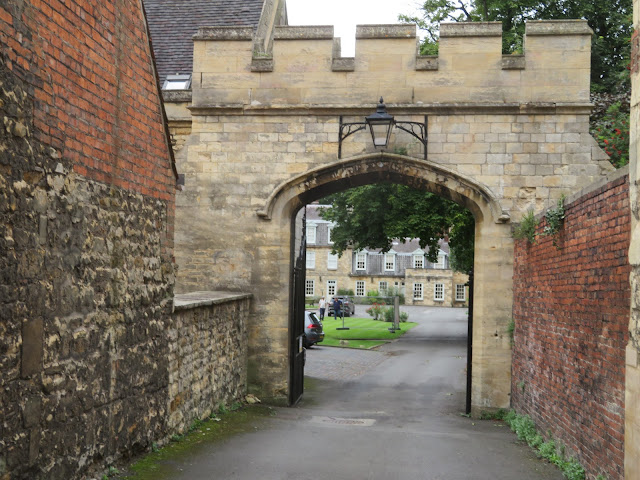We moored up safe from the wind and as were were not going anywhere our daughter was popping over from Hull for the night. We had the day to kill. This weekend was to be the 1940's weekend in Lincoln. Much didn't happen as they couldn't put up tents etc. Helen was very disappointed as the RAF Memorial Flight fly past was cancelled due to the weather.
The foot bridge over the road on Waterside South gives you a great view of the cathedral. The left hand lanes were empty as further chaos was occurring due to an accident that had closed the road and traffic was stacked up all round the city centre.
This is actually the building that sits on top of the Glory Hole, the mouse hole that lets the River Witham under High Street. It was actually built in 1540 and now seems to be a tea shop where the waitresses where black and little caps like at Betty's.
There is the glory hole, or High Bridge, with the back of the building. The bridge is said to be the oldest surviving in the country and dates from 1160. A chapel was built on top of it to Thomas a Becket in 1235 but was lost in the Reformation.
These are some of the crowds at the top of Steep Hill. The house give a lovely aspect as. I wonder what the criteria is/was. you look down the slope. Steep Hill was proclaimed the 'Best Street in the Country, 2012'
They don't make them like this now as it has been dated as been built between 1170 and 1180. It is known as the Norman House for the era it was built. You do get an idea of the steepness of Steep Hill in the photo too.
From Michaelgate looking back at the Norman House and the towers of the cathedral behind (you can't see the scaffolding or sheets of plastic that shroud a lot of it at the moment) you can see what is called Crooked Cottage. It seems there was a whole row of these going down the hill behind the camera but where knocked down in the 60's. They were Alms Houses and then council houses, and there was always a long waiting list for them. Now it is a holiday home if you fancy stopping there.
This is the side entrance to the cathedraland is called the Bishop's Entrance as this is where he would enter as it was the closest to the Bishop's Palace.
The Bishop's Palace was just down the hill and set in gardens. In fact there were two here. One I think has now recently been converted to an hotel. The other was ruined but is in the hands of English Hetitage but they are doing a lot of work on it so is not open. This is looking through to the hotel
This is the entrance to Saint Hugh's Shrine that was built in the second half of the 13th Century. They basically built/extended the back of the church to make it even bigger. St. Hugh was the bishop of Lincoln and was a French Noble monk. He was made a saint very quickly after his death and was second in England to Thomas a Becket, so the shrine was a great attraction for the pilgrim pound.
I loved this window in the music school of the cathedral with the heads and shields.
Is this Arts and Crafts era? What ever it is it is quite something and I would be washing it all the time to keep it bright and shiny.
And to take us right back here is the biggest Roman Wall in England. It was actually the west wall of the Roman Basilica. Lincoln, or Lindum was a big Roman city and was on Ermine Street that actually passed up Steep Hill. Even when the Romans left a lot of those who remained made it home and so extended the life of it.












No comments:
Post a Comment